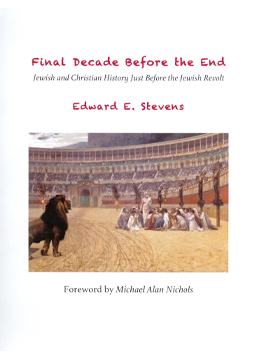One Column Page
and responsive to boot
Fall of Masada in AD 73
by Edward E. Stevens
This article appeared in the
2023 Winter issue of Fulfilled! Magazine

Our previous article ended with the Roman capture of Herodium and Machaerus, as well as the Romans’ suppression of two different post-war Jewish insurrections in Alexandria and Cyrene. And since the Roman General Lucilius Bassus died not long after he captured Machaerus, he was quickly replaced by General Flavius Silva, who then took charge of the assault on Masada, which was the final outpost of the Zealot rebellion [Josephus Wars 7:252 (7.8.1)].
In this article we will deal with the Fall of Masada, including how its wall was breached, how its Jewish defenders died in a massive suicide pact, and how its capture marked the death of the Man of Lawlessness (2 Thess 2:8), the end of the rebellion, and the “complete shattering” of the Jewish people.
Eleazar Was the Leader at Masada
According to Hegesippus (Heg. 2:10), at the beginning of the rebellion (AD 66), after Eleazar b. Ananias killed Menahem, forces allied with Eleazar took control of Masada and placed a garrison there.
Both Yosippon and Hegesippus claim that just before the siege of Jerusalem began in May of 70, Eleazar then fled from Jerusalem to Masada, where he subsequently led the Zealots in their fatal defense of that fortress [Sepher Yosippon (chs. 82, 89); Heg. (5.53); cf. Wars 5.102 (5.3.1)]. See our previous articles (Summer 2021, Spring 2022, and Summer 2023) for the historical and archaeological evidence supporting the presence of Eleazar at Masada after he fled from Jerusalem in May of 70.
Titus Sent Silva to Masada
According to Yosippon, when Titus learned that Eleazar had escaped to Masada, he sent General Flavius Silva with a large force to make sure Eleazar did not elude capture again [Sepher Yosippon ch. 89].
As General Silva moved his troops toward Masada, he cleared out all remaining pockets of resistance in the area, and then surrounded Masada. The Zealot defenders were now totally cut off from the outside world. They had plenty of food and water, but they had no hope of victory or escape. They were outnumbered ten-to-one [Wars 7:275-279 (7.8.2)].
Masada held out for almost three years against the Romans, but in May of 73 the Romans were able to get their battering ram on top of the ramp at Masada and break through the walls. Josephus, Yosippon, and Hegesippus give us a lot of details about it.
Slain by the Breath of His Mouth
Paul stated in 2 Thessalonians 2:8 that the Lord Jesus would slay the Lawless One “by the breath of His mouth.” In the previous chapter (2 Thess 1:7) Paul predicted that Christ would come “in flaming fire [Gk. puri phlogos] dealing out retribution” to their persecutors. Here, at the capture of Masada, we see the “breath [Gk. pneumati] of His mouth” driving the “flaming fire” which destroyed Masada’s wooden wall of defense.
Note that the same three Greek words for flaming, fire, and breath are used by both Paul (2 Thess 1:7; 2:8) and Josephus [Wars 7:314-321 (7.8.5-6)]. Furthermore, Josephus attributed the destruction of the wall by a wind-driven fire to “divine providence [and] assistance from God”:
This [wooden wall] of theirs was like a real edifice; and when the machines were applied, the blows were weakened by its yielding . . . . When Silva saw this, he thought it best to [destroy] this wall by setting fire [Gk. puri] to it; so he gave order . . . and when it was once set on fire, its hollowness made that fire spread to a mighty flame [Gk. phloga]. . . . after this, on a sudden the wind changed into the south, as if it were done by divine Providence; and blew [Gk. pneusas] strongly the contrary way, and carried the flame, and drove it against the wall, which was now on fire through its entire thickness. So the Romans, having now assistance from God, returned to their camp with joy, and resolved to attack their enemies the very next day . . . [but when Eleazar] saw their wall burnt down by the fire [Gk. puros], and could devise no other way of escaping, or room for their farther courage, and setting before their eyes what the Romans would do to them, their children, and their wives, if they got them into their power, he consulted about having them all slain. [Wars 7:314–321 (7.8.5-6) bracketed material and boldface added].
Hegesippus also described the burning of the wooden wall, and quotes Eleazar as admitting that it was God who caused the “breath of the south wind” to turn the fire against their wooden fortifications and completely consume them:
Silva diligently pursuing the task imposed upon him, destroyed the wall of Masada with the battering ram. They had constructed the interior with wood for the reason that the wall material would not readily yield to the blows of siege machines of this type. But the Romans, the manner of fighting having been changed, threw fire, which both easily stuck fast to the wood and grew strong without any delay. And so a great roar was produced by the full grown conflagration of the blaze, which at first was driven back from parts of the fortification by the breath of the north wind and instead burned the shelters of the Romans, then the breath of the south wind having arisen turned itself back against the fortress, so that the material having been consumed all that wooden wall opposed burned up. . . . [Then Eleazar said] O unhappy people, to what hope of this life will we reserve ourselves . . . since the displeasure of God is evident? The fires have been turned round from the enemy against us, the breezes of the winds have been changed, the flames turned back, so that our reinforcements were burned down. Who will be able to live with God opposing? . . . [Heg. 5.53, bracketed material and boldface added].
Furthermore, 2 Thessalonians 2:8 states that the Man of Sin would be “slain” (Gk. anaireō), a word that is used 451 times in the works of Josephus describing all the slaughters and killings that occurred during the war. This same word was used by Josephus three times in the context of the suicide killings on Masada:
So they being not able to bear the grief they were under for what they had done any longer [by slaying all their families], and esteeming it an injury to those they had slain [Gk. anaireō] to live even the shortest space of time after them . . . [Wars 7:394 (7.9.1)]
. . . and when these ten had, without fear, slain them all, they made the same rule for casting lots for themselves, that he whose lot it was should first kill the other nine, and after all, should kill [Gk. anaireō] himself . . . [Wars 7:396 (7.9.1)]
. . . when [the last man standing] perceived that they were all slain [Gk. anaireō], he set fire to the palace, and with the great force of his hands ran his sword entirely through himself, and fell down dead near to his own relations [Wars 7.397 (7.9.1)].
Eleazar was “the originator of the [rebellion]” (Heg. 5.53), and was one of the last to be slain. He died at Masada with 960 others in a final suicide pact, slain by his own soldiers. The mass suicide occurred on the fifteenth day of the month Xanthicus (Nisan), evidently during Passover week in May of 73 [Wars 7:401 (7.9.1); Wars 7.413 (7.10.1)].
While Hegesippus seems to agree with Josephus on this mass suicide pact of all 960 of them, Yosippon has a little different ending to the story. Instead of Eleazar and the fighting men killing themselves, they instead slew only their wives, children and aged elders. Then at the first light of morning the remaining fighting men rushed out of Masada, charged the Romans, and fought until every last one of them (including Eleazar) was killed by the Romans (Sepher Yosippon, ch. 89). We may never know which of these two scenarios is correct, but it doesn’t really matter since neither of them changes the outcome.
Eleazar Fits All the Characteristics
Thus, we have seen that Eleazar b. Ananias seems to be the only one who matches all of the characteristics of the Man of Lawlessness that are mentioned in 2 Thessalonians 2. He was the one who blew the shofar and started the rebellion [Sepher Yosippon ch. 59]. He was the only one who “sat in the temple” during the war. Ananus II never had control of the Temple during the war, and John of Gischala only gained control of it at the very end just before the siege began (May of 70), at a time when holding the Temple no longer mattered.
And although both John of Gischala and Ananus II were guilty of many lawless deeds, none were so extremely lawless as Eleazar, who violated all the laws and set himself up as the lawmaker instead of God.
Furthermore, Ananias b. Nedebaeus, Menahem, and Ananus II were all killed during the war. Simon b. Giora and John of Gischala both surrendered to Titus and were taken to Rome to be displayed in his triumphal parade. After being dragged through the crowd and tormented by them, Simon was finally thrown over the Tarpeian cliff in sacrifice to the Roman gods, while John of Gischala was held in chains in a Roman prison for the rest of his life.
Thus, Eleazar b. Ananias is the only one of the Zealot leaders who was slain by his own men at Masada when their last hope of defense was destroyed by the breath of our Lord’s mouth (2 Thess 2:8). The rebellion was crushed, and the power of the Jewish people was completely shattered (Dan 12:7). V
This ends our series on the History of the End. And since I am having some health issues right now and need some additional time to research the next series of articles, History AFTER the End, I will be taking a break from the next two quarterly issues of Fulfilled! Magazine. Lord willing, when I return, we will begin looking at the first generation of Jewish and Christian history after the Fall of Masada.
If you wish to have more details on the identification of Eleazar as the Man of Lawlessness, simply send me an email request for PDF copies of the following articles and charts:
• Abomination, Rebellion, and Lawlessness (Summer 2021)
• The Man of Lawlessness Revealed (Spring 2022)
• Outbreak of Rebellion: The Real History
• Titus Laid Siege to Jerusalem (Summer 2023)
• Eleazar_Chart.jpg
You might also want to check out our historical podcasts (www.buzzsprout.com/11633), and get a copy of my historical book, Final Decade Before the End, found here: www.preterist.org/product-cat/all/
Comments:
Your honest review will help others in their search for truth. If you must leave a negative review please be gracious.
Rather, speaking the truth in love, we are to grow up in every way into him who the head, into Christ . . . .
(Ephesians 4:15)
We use "Disqus" commenting software. If you are not familiar with "Disqus," click here for more information. You don't need a Disqus account to post comments, however, without an account you won't be notified if someone responds to your post.
 Fulfilled
Fulfilled